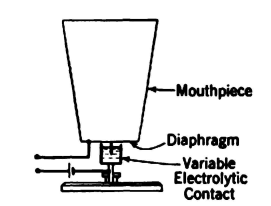| Electrical Communication is a free textbook on the basics of communication technology. See the editorial for more information.... |

|

Home  Early History of Electrical Communication Early History of Electrical Communication  The Invention of the Electric Telephone The Invention of the Electric Telephone |
||||||||||






|
||||||||||
The Invention of the Electric TelephoneThe telephone by which speech was first transmitted electrically was invented by Alexander Graham Bell. He was the descendant of a line of men famous in speech, elocution, and acoustics. His grandfather, Alexander Bell, was a professor of elocution.10 His father, Alexander Melville Bell, followed this same calling in Edinburgh and London. He specialized in treating stammering pupils.
To seek a more healthful climate for young Bell, the family left England and settled in Canada. In 1871 he went to Boston, where he taught a class of deaf mutes. He was later made a professor in Boston University and opened his own School of Vocal Physiology. Bell's early efforts were directed toward a harmonic or musical telegraph. As his investigation proceeded, he became convinced that the human voice could be conveyed by electrical means. Bell made a statement which showed that he had conceived the correct solution to the problem. According to Watson, who was Bell's assistant in the investigations, he said:12 "If I could make a current of electricity vary in intensity, precisely as the air varies in density during the production of a sound, I should be able to transmit speech telegraphically." About this same time Bell visited Henry, who was then foremost in electrical science in America. He explained his ideas and demonstrated certain experiments to Henry, and was told7 that he possessed "the germ of a great invention." Bell remarked that he felt that he did not have the electrical knowledge required to overcome certain difficulties and was advised by Henry to "get it."
It was on June 2, 1875, that the first sounds were transmitted by Bell and Watson as they were experimenting with their harmonic telegraph apparatus shown in Fig. 3. The manner in which it occurred can best be told in Watson's own words:18
I had charge of the transmitters, as usual, setting them squealing one after the other, while Bell was retiming the receiver springs one by one, pressing them against his ear as I have described. One of the transmitter springs I was attending to stopped vibrating and I plucked it to start it again. It didn't start and I kept on plucking it, when suddenly I heard a shout from Bell in the next room, and then out he came with a rush, demanding, "What did you do then? Don't change anything. Let me see!" I showed him. It was very simple. The contact screw was screwed down so far that it made permanent contact with the spring, so that when I snapped the spring the circuit had remained unbroken while the strip of magnetized steel by its vibration over the pole of its magnet was generating that marvelous conception of Bell's - a current of electricity that varied in intensity precisely as the air was varying in density within hearing distance of that spring.(1)
Bell immediately gave Watson directions for constructing the first telephone. This instrument was not satisfactory, and when it was tried only a few faint tones were heard. Bell recognized that the generated currents from his transmitter were very weak, and accordingly he devised the liquid or electrolytic transmitter shown in Fig. 4. The current from a battery was caused to vary in accordance with the sound waves striking the transmitter by the variable liquid contact. It was with an instrument of this type that on March 10, 1876, Bell spoke the first sentence,13 "Mr. Watson, come here, I want you."
When exhibited at the Centennial Exposition in Philadelphia, the telephone attracted very little attention and was even ridiculed. It happened, however, that at the time the judges were about to leave without trying Bell's set, a fortunate incident occurred.11 The Emperor of Brazil, Dom Pedro de Alcantara, walked in and greeted Bell. The Emperor had met Bell at Boston University, where he visited one of Bell's classes of deaf mutes. The Emperor examined the telephone receiver, and Bell went to the transmitter. Bell spoke into the transmitter, and to the utter amazement of the onlookers, the Emperor exclaimed: "My God - it talks." The telephone immediately became the center of attraction.
|
||||||||||
Home  Early History of Electrical Communication Early History of Electrical Communication  The Invention of the Electric Telephone The Invention of the Electric Telephone |
||||||||||
Last Update: 2011-06-06



